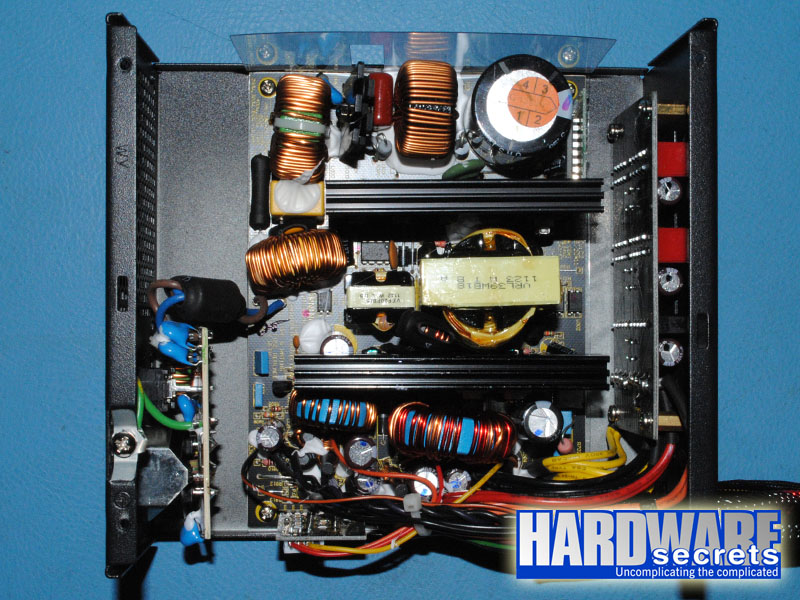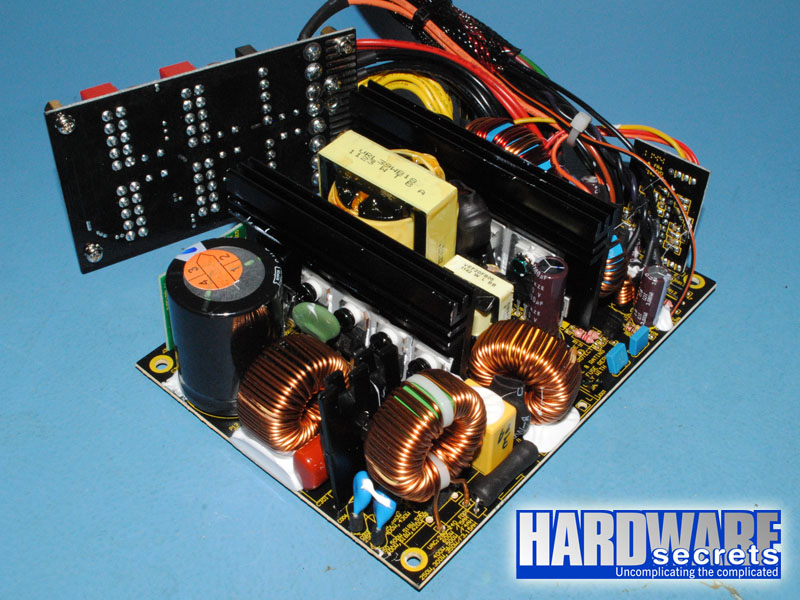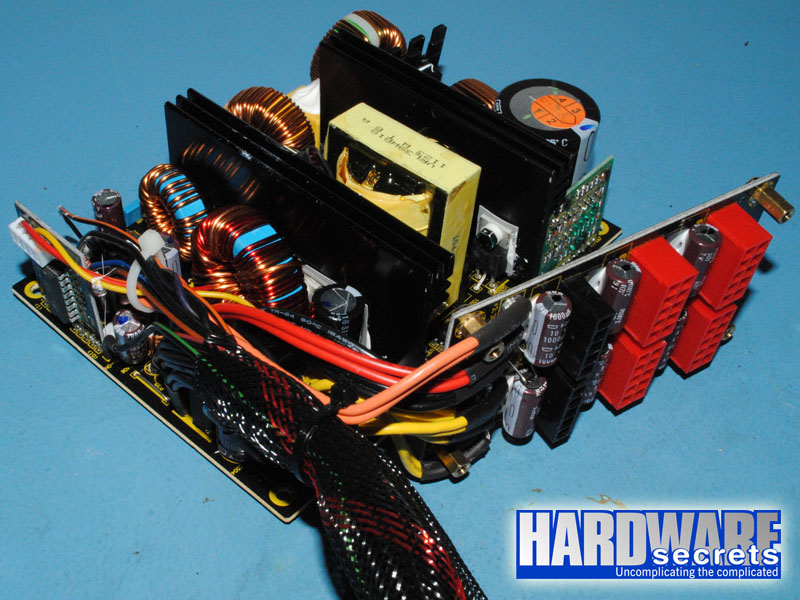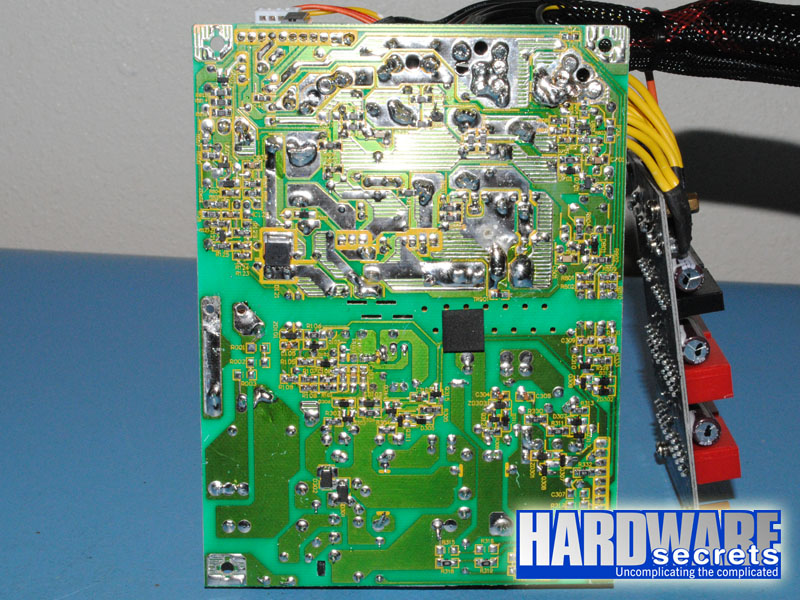[nextpage title=”Introduction”]
The new High Current Gamer M is a version of Antec’s High Current Gamer power supply series with a modular cabling system. So far, only three models are available: 400 W, 520 W, and 620 W. The original High Current Gamer series also has a 750 W and a 900 W model. All models have the 80 Plus Bronze certification and single +12 V rail design. Let’s take an in-depth look at the 620 W model from this new series, also known as HCG-620M.
The three models from the “M” series are manufactured by Seasonic. On the original series, the models from 400 W to 620 W are also manufactured by Seasonic, but the 750 W and 900 W models are manufactured by Delta.
Figure 1: High Current Gamer M 620 W power supply
Figure 2: High Current Gamer M 620 W power supply
The High Current Gamer M 620 W is 6.3” (160 mm) deep, using a 135 mm dual ball bearing fan on its bottom (ADDA ADN512MB-A90).
This unit has a modular cabling system with six connectors, four for video cards (red) and two for SATA and peripheral power connectors (black). The motherboard cables come permanently attached to the power supply, and they are protected with nylon sleeves that come from inside the unit. This power supply comes with the following cables:
- Main motherboard cable with a 20/24-pin connector, 21.3” (54 cm) long, permanently attached to the power supply
- One cable with two ATX12V connectors that together form an EPS12V connector, 25.2” (64 cm) long, permanently attached to the power supply
- Two cables, each with one six/eight-pin connector for video cards, 21.6” (55 cm) long, modular cabling system
- Two cables, each with three SATA power connectors, 21.6” (55 cm) to the first connector, 5.9” (15 cm) between connectors, modular cabling system
- One cable with three standard peripheral power connectors, 21.6” (55 cm) to the first connector, 5.9” (15 cm) between connectors, modular cabling system
- One cable with three standard peripheral power connectors and one floppy disk drive power connector, 21.6” (55 cm) to the first connector, 5.9” (15 cm) between connectors, modular cabling system
All wires are 18 AWG, which is the minimum recommended gauge.
The cable configuration is adequate for a 620 W power supply.
Figure 3: Cables
Let’s now take an in-depth look inside this power supply.
[nextpage title=”A Look Inside the High Current Gamer M 620 W”]
We decided to disassemble this power supply to see what it looks like inside, how it is designed, and what components are used. Please read our “Anatomy of Switching Power Supplies” tutorial to understand how a power supply works and to compare this power supply to others.
On this page we will have an overall look, and then in the following pages we will discuss in detail the quality and ratings of the components used.

Figure 4: Top view

Figure 5: Front quarter view

Figure 6: Rear quarter view

Figure 7: The printed circuit board
[nextpage title=”Transient Filtering Stage”]
As we have mentioned in other articles and reviews, the first place we look when opening a power supply for a hint about its quality, is its filtering stage. The recommended components for this stage are two ferrite coils, two ceramic capacitors (Y capacitors, usually blue), one metalized polyester capacitor (X capacitor), and one MOV (Metal-Oxide Varistor). Very low-end power supplies use fewer components, usually removing the MOV and the first coil.
In the transient filtering stage, this power supply has four Y capacitors and one X capacitor more than the minimum required.
Figure 8: Transient filtering stage (part 1)
Figure 9: Transient filtering stage (part 2)
On the next page, we will have a more detailed discussion about the components used in the High Current Gamer M 620 W.
[nextpage title=”Primary Analysis”]
On this page we will take an in-depth look at the primary stage of the High Current Gamer M 620 W. For a better understanding, please read our “Anatomy of Switching Power Supplies” tutorial.
This power supply uses one GBU1006 rectifying bridge, which is attached to an individual heatsink. This bridge supports up to 10 A at 100° C, so in theory, you would be able to pull up to 1,150 W from a 115 V power grid. Assuming 80% efficiency, the bridge would allow this unit to deliver up to 920 W without burning itself out. Of course, we are only talking about this particular component. The real limit will depend on all the components combined in this power supply.
Figure 10: Rectifying bridge
The active PFC circuit uses two SPP20N60C3 MOSFETs, each one supporting up to 20.7 A at 25° C or 13.1 A at 100° C in continuous mode (note the difference temperature makes), or 62.1 A at 25° C in pulse mode. These transistors present a 190 mΩ resistance when turned on, a characteristic called RDS(on). The lower the number the better, meaning that the transistor will waste less power, and the power supply will have a higher efficiency.
Figure 11: One of the switching transistors, the active PFC diode and the active PFC transistors
The output of the active PFC circuit is filtered by one 470 µF x 400 V Japanese electrolytic capacitor from Chemi-Con, labeled at 85° C.
In the switching section, another two SPP20N60C3 MOSFETs are employed using the traditional two-transistor forward configuration. The specifications for these transistors were already discussed above.
The primary is managed by an ICE1CS02 active PFC/PWM combo controller.
Figure 12: Active PFC/PWM combo controller
Let’s now take a look at the secondary of this power supply.
[nextpage title=”Secondary Analysis”]
The Antec High Current Gamer M 620 W uses a regular design in its secondary, with Schottky rectifiers.
The maximum theoretical current each line can deliver is given by the formula I / (1 – D) where D is the duty cycle used and I is the maximum current supported by the rectifying diode. As an exercise, we can assume a duty cycle of 30 percent.
The +12 V output uses three SBR30A50CT Schottky rectifiers, each one supporting up to 30 A (15 A per internal diode at 110° C with a 0.55 V maximum voltage drop). From the six diodes available (two per rectifier pack), two are used for the direct rectification, while four are used for the “freewheeling” part of the rectification. This gives us a maximum theoretical current of 43 A or 514 W for the +12 V output.
The +5 V output uses one SBR40U45CT Schottky rectifier, which supports up to 40 A (20 A per internal diode at 110° C with a 0.52 V maximum voltage drop). This gives us a maximum theoretical current of 29 A or 143 W for the +5 V output.
The +3.3 V output uses one MBR30H30CTG, which supports up to 30 A (15 A per internal diode at 138° C with a 0.55 V maximum voltage drop). This gives us a maximum theoretical current of 21 A or 71 W for the +3.3 V output.
Note in Figures 13 and 14 how there is a metallic plate between the rectifiers and the heatsink in order to improve thermal dissipation.
Figure 13: One of the +12 V rectifiers, the +5 V rectifier, and the +3.3 V rectifier
Figure 14: The other two +12 V rectifiers
This power supply uses a PS223 monitoring integrated circuit, which supports over voltage (OVP), under voltage (UVP), over current (OCP), and over temperature (OTP) protections. This chip offers two +12 V over current protection channels, but the manufacturer decided to use only one of them to make this unit have a single +12 V rail.
Figure 15: Monitoring circuit
The electrolytic capacitors that filter the +12 V output are also Japanese, from Chemi-Con, and are labeled at 105° C, as usual.
[nextpage title=”Power Distribution”]
In Figure 16, you can see the power supply label containing all the power specs.
Figure 16: Power supply label
This power supply uses a single +12 V rail design, so there is not much to talk about here.
How much power can this unit really deliver? Let’s find out.
[nextpage title=”Load Tests”]
We conducted several tests with this power supply, as described in the article, “Hardware Secrets Power Supply Test Methodology.”
First we tested this power supply with five different load patterns, trying to pull around 20%, 40%, 60%, 80%, and 100% of its labeled maximum capacity (actual percentage used listed under “% Max Load”), watching the behavior of the reviewed unit under each load. In the table below, we list the load patterns we used and the results for each load.
If you add all the powers listed for each test, you may find a different value than what is posted under “Total” below. Since each output can have a slight variation (e.g., the +5 V output working at +5.10 V), the actual total amount of power being delivered is slightly different than the calculated value. In the “Total” row, we are using the real amount of power being delivered, as measured by our load tester.
The +12VA and +12VB inputs listed below are the two +12 V independent inputs from our load tester. During this test, the +12VA and +12VB inputs were connected to the power supply’s single +12 V rail.
| Input | Test 1 | Test 2 | Test 3 | Test 4 | Test 5 |
| +12VA | 4 A (48 W) | 9 A (108 W) | 13 A (156 W) | 17.5 A (210 W) | 22.5 A (270 W) |
| +12VB | 4 A (48 W) | 9 A (108 W) | 13 A (156 W) | 17.5 A (210 W) | 22 A (264 W) |
| +5 V | 1 A (5 W) | 2 A (10 W) | 4 A (20 W) | 6 A (30 W) | 8 A (40 W) |
| +3.3 V | 1 A (3.3 W) | 2 A (6.6 W) | 4 A (13.2 W) | 6 A (19.8 W) | 8 A (26.4 W) |
| +5VSB | 1 A (5 W) | 1 A (5 W) | 1.5 A (7.5 W) | 2 A (10 W) | 3 A (15 W) |
| -12 V | 0.5 A (6 W) | 0.5 A (6 W) | 0.5 A (6 W) | 0.5 A (6 W) | 0.5 A (6 W) |
| Total | 115.1 W | 239.0 W | 356.4 W | 481.9 W | 618.5 W |
| % Max Load | 18.6% | 38.5% | 57.5% | 77.7% | 99.8% |
| Room Temp. | 44.6° C | 44.8° C | 46.3° C | 48.1° C | 49.5° C |
| PSU Temp. | 44.3° C | 44.8° C | 45.4° C | 46.2° C | 50.2° C |
| Voltage Regulation | Pass | Pass | Pass | Pass | Pass |
| Ripple and Noise | Pass | Pass | Pass | Pass | Pass |
| AC Power | 135.7 W | 277.4 W | 418.2 W | 575.2 W | 759.0 W |
| Efficiency | 84.8% | 86.2% | 85.2% | 83.8% | 81.5% |
| AC Voltage | 119.2 V | 117.5 V | 116.2 V | 114.5 V | 112.6 V |
| Power Factor |
0.993 |
0.993 |
0.995 |
0.995 |
0.995 |
| Final Result | Pass | Pass | Pass | Pass | Pass |
The High Current Gamer M 620 W passed our tests.
Efficiency was between 81.5% and 86.2% during our tests. The 80 Plus Bronze certification promises minimum efficiency of 82% at full load, but this power supply presented efficiency a half point below this number during our tests. Having this occur during our tests is normal, since the 80 Plus certification tests are conducted at 23° C, and we test power supplies between 45° C and 50° C; efficiency drops with higher temperature.
Voltages were closer to their nominal values (3% regulation) during all tests, except during test one, when the -12 V output was below this tighter range, at -11.63 V, still inside the allowed margin. The ATX12V specification states that positive voltages must be within 5% of their nominal values, and negative voltages must be within 10% of their nominal values.
Let’s discuss the ripple and noise levels on the next page.
[nextpage title=”Ripple and Noise Tests”]
Voltages at the power supply outputs must be as “clean” as possible, with no noise or oscillation (also known as “ripple”). The maximum ripple and noise levels allowed are 120 mV for +12 V and -12 V outputs, and 50 mV for +5 V, +3.3 V and +5VSB outputs. All values are peak-to-peak figures. We consider a power supply as being top-notch if it can produce half or less of the maximum allowed ripple and noise levels.
The High Current Gamer M 620 W provided extremely low ripple and noise levels, as you can see in the table below.
| Input | Test 1 | Test 2 | Test 3 | Test 4 | Test 5 |
| +12VA | 7.2 mV | 7.2 mV | 8.8 mV | 9.8 mV | 15.4 mV |
| +12VB | 9.0 mV | 10.2 mV | 12.2 mV | 13.8 mV | 23.6 mV |
| +5 V | 6.8 mV | 6.4 mV | 6.6 mV | 6.4 mV | 7.0 mV |
| +3.3 V | 6.4 mV | 7.2 mV | 8.2 mV | 7.8 mV | 8.4 mV |
| +5VSB | 9.6 mV | 9.8 mV | 12.6 mV | 13.2 mV | 18.6 mV |
| -12 V | 7.8 mV | 7.6 mV | 9.2 mV | 11.8 mV | 13.8 mV |
Below you can see the waveforms of the outputs during test five.
Figure 17: +12VA input from load tester during test five at 618.5 W (15.4 mV)
Figure 18: +12VB input from load tester during test five at 618.5 W (23.6 mV)
Figure 19: +5V rail during test five at 618.5 W (7 mV)
Figure 20: +3.3 V rail during test five at 618.5 W (8.4 mV)
Let’s see if we can pull more than 620 W from this unit.
[nextpage title=”Overload Tests”]
Below you can see the maximum we could pull from this power supply. The objective of this test is to see if the power supply has its protection circuits working properly. The unit passed this test, as we couldn’t pull more than shown in the table below because the power supply would shut down, showing that its protections are present and working fine. During this extreme configuration, noise and ripple levels were still extremely low, and voltages were still within three percent of their nominal values.
| Input | Overload Test |
| +12VA | 25 A (300 W) |
| +12VB | 25 A (300 W) |
| +5 V | 12 A (60 W) |
| +3.3 V | 12 A (39.6 W) |
| +5VSB | 3 A (15 W) |
| -12 V | 0.5 A (6 W) |
| Total | 714.2 W |
| % Max Load | 115.2% |
| Room Temp. | 45.6° C |
| PSU Temp. | 42.8° C |
| AC Power | 899 W |
| Efficiency | 79.4% |
| AC Voltage | 111.1 V |
| Power Factor | 0.995 |
[nextpage title=”Main Specifications”]
The main specifications for the High Current Gamer M 620 W power supply include:
- Standards: NA
- Nominal labeled power: 620 W
- Measured maximum power: 714.2 W at 45.6° C
- Labeled efficiency: Up to 87%, 80 Plus Bronze certification
- Measured efficiency: Between 81.5% and 86.2%, at 115 V (nominal, see complete results for actual voltage)
- Active PFC: Yes
- Modular Cabling System: Yes
- Motherboard Power Connectors: One 20/24-pin connector and two ATX12V connectors that together form an EPS12V connector, permanently attached to the power supply
- Video Card Power Connectors: Two six/eight-pin connectors on two cables, modular cabling system
- SATA Power Connectors: Six on two cables, modular cabling system
- Peripheral Power Connectors: Six on two cables, modular cabling system
- Floppy Disk Drive Power Connectors: One
- Prote
ctions (as listed by the manufacturer): Over voltage (OVP), under voltage (UVP), over current (OCP), over power (OPP), and short-circuit (SCP) protections - Are the above protections really available? Yes
- Warranty: Five years
- Real Manufacturer: Seasonic
- More Information: https://www.antec.com
- Average Price in the U.S.*: USD 100.00
* Researched at Newegg.com on the day we published this review.
[nextpage title=”Conclusions”]
The Antec High Current Gamer M 620 W proved to be an outstanding mainstream power supply with modular cabling system, with efficiency between 81.5% and 86.2%, voltages closer to their nominal values than necessary (three percent regulation), and extremely low noise and ripple levels. (Which, by the way, is becoming Seasonic’s trademark.)
The only negative aspect we could complain about with this unit is its price, as for the same price you can buy the Antec High Current Gamer 750 W. However, both quality-wise and performance-wise, the Antec High Current Gamer M 620 W is superior to the High Current Gamer 750 W.

















Leave a Reply